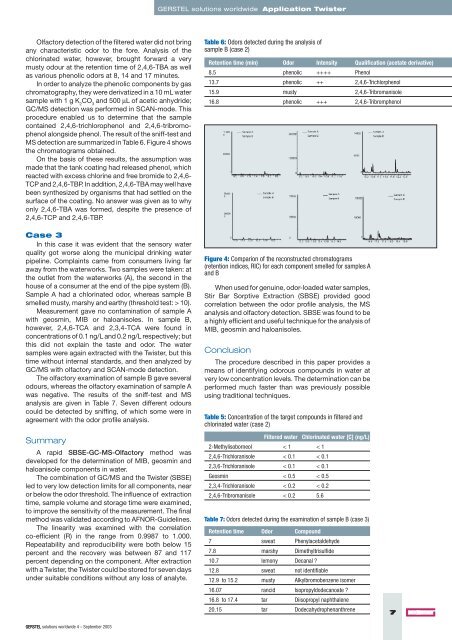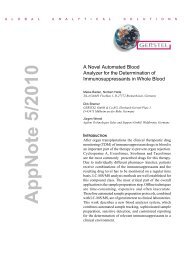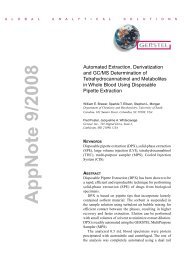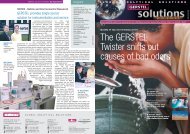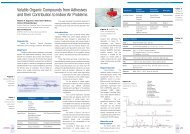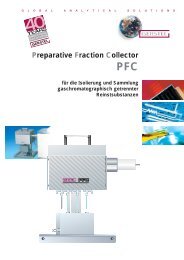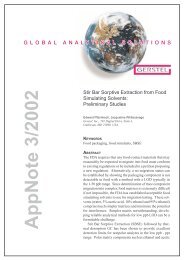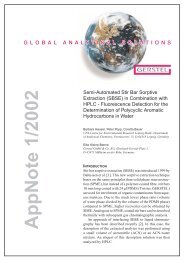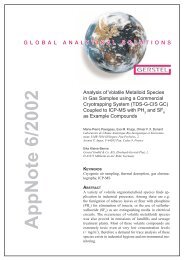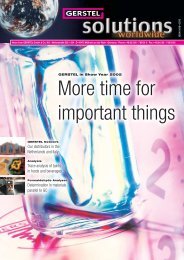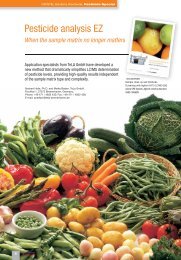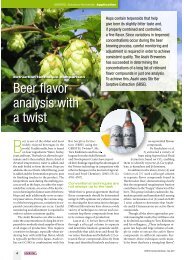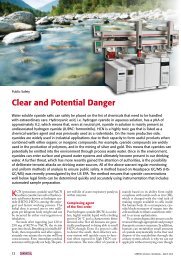GERSTEL Twister sniffs out causes of bad odors
GERSTEL Twister sniffs out causes of bad odors
GERSTEL Twister sniffs out causes of bad odors
You also want an ePaper? Increase the reach of your titles
YUMPU automatically turns print PDFs into web optimized ePapers that Google loves.
<strong>GERSTEL</strong> solutions worldwide Application <strong>Twister</strong><br />
Olfactory detection <strong>of</strong> the filtered water did not bring<br />
any characteristic odor to the fore. Analysis <strong>of</strong> the<br />
chlorinated water, however, brought forward a very<br />
musty odour at the retention time <strong>of</strong> 2,4,6-TBA as well<br />
as various phenolic <strong>odors</strong> at 8, 14 and 17 minutes.<br />
In order to analyze the phenolic components by gas<br />
chromatography, they were derivatized in a 10 mL water<br />
sample with 1 g K 2<br />
CO 3<br />
and 500 µL <strong>of</strong> acetic anhydride;<br />
GC/MS detection was performed in SCAN-mode. This<br />
procedure enabled us to determine that the sample<br />
contained 2,4,6-trichlorophenol and 2,4,6-tribromophenol<br />
alongside phenol. The result <strong>of</strong> the sniff-test and<br />
MS detection are summarized in Table 6. Figure 4 shows<br />
the chromatograms obtained.<br />
On the basis <strong>of</strong> these results, the assumption was<br />
made that the tank coating had released phenol, which<br />
reacted with excess chlorine and free bromide to 2,4,6-<br />
TCP and 2,4,6-TBP. In addition, 2,4,6-TBA may well have<br />
been synthesized by organisms that had settled on the<br />
surface <strong>of</strong> the coating. No answer was given as to why<br />
only 2,4,6-TBA was formed, despite the presence <strong>of</strong><br />
2,4,6-TCP and 2,4,6-TBP.<br />
Case 3<br />
In this case it was evident that the sensory water<br />
quality got worse along the municipal drinking water<br />
pipeline. Complaints came from consumers living far<br />
away from the waterworks. Two samples were taken: at<br />
the <strong>out</strong>let from the waterworks (A), the second in the<br />
house <strong>of</strong> a consumer at the end <strong>of</strong> the pipe system (B).<br />
Sample A had a chlorinated odor, whereas sample B<br />
smelled musty, marshy and earthy (threshold test: > 10).<br />
Measurement gave no contamination <strong>of</strong> sample A<br />
with geosmin, MIB or haloanisoles. In sample B,<br />
however, 2,4,6-TCA and 2,3,4-TCA were found in<br />
concentrations <strong>of</strong> 0.1 ng/L and 0.2 ng/L respectively; but<br />
this did not explain the taste and odor. The water<br />
samples were again extracted with the <strong>Twister</strong>, but this<br />
time with<strong>out</strong> internal standards, and then analyzed by<br />
GC/MS with olfactory and SCAN-mode detection.<br />
The olfactory examination <strong>of</strong> sample B gave several<br />
odours, whereas the olfactory examination <strong>of</strong> sample A<br />
was negative. The results <strong>of</strong> the sniff-test and MS<br />
analysis are given in Table 7. Seven different odours<br />
could be detected by sniffing, <strong>of</strong> which some were in<br />
agreement with the odor pr<strong>of</strong>ile analysis.<br />
Table 6: Odors detected during the analysis <strong>of</strong><br />
sample B (case 2)<br />
Retention time (min) Odor Intensity Qualification (acetate derivative)<br />
8.5 phenolic ++++ Phenol<br />
13.7 phenolic ++ 2,4,6-Trichlorphenol<br />
15.9 musty 2,4,6-Tribromanisole<br />
16.8 phenolic +++ 2,4,6-Tribromphenol<br />
Figure 4: Comparion <strong>of</strong> the reconstructed chromatograms<br />
(retention indices, RIC) for each component smelled for samples A<br />
and B<br />
When used for genuine, odor-loaded water samples,<br />
Stir Bar Sorptive Extraction (SBSE) provided good<br />
correlation between the odor pr<strong>of</strong>ile analysis, the MS<br />
analysis and olfactory detection. SBSE was found to be<br />
a highly efficient and useful technique for the analysis <strong>of</strong><br />
MIB, geosmin and haloanisoles.<br />
Conclusion<br />
The procedure described in this paper provides a<br />
means <strong>of</strong> identifying odorous compounds in water at<br />
very low concentration levels. The determination can be<br />
performed much faster than was previously possible<br />
using traditional techniques.<br />
Table 5: Concentration <strong>of</strong> the target compounds in filtered and<br />
chlorinated water (case 2)<br />
Summary<br />
A rapid SBSE-GC-MS-Olfactory method was<br />
developed for the determination <strong>of</strong> MIB, geosmin and<br />
haloanisole components in water.<br />
The combination <strong>of</strong> GC/MS and the <strong>Twister</strong> (SBSE)<br />
led to very low detection limits for all components, near<br />
or below the odor threshold. The influence <strong>of</strong> extraction<br />
time, sample volume and storage time were examined,<br />
to improve the sensitivity <strong>of</strong> the measurement. The final<br />
method was validated according to AFNOR-Guidelines.<br />
The linearity was examined with the correlation<br />
co-efficient (R) in the range from 0.9987 to 1.000.<br />
Repeatability and reproducibility were both below 15<br />
percent and the recovery was between 87 and 117<br />
percent depending on the component. After extraction<br />
with a <strong>Twister</strong>, the <strong>Twister</strong> could be stored for seven days<br />
under suitable conditions with<strong>out</strong> any loss <strong>of</strong> analyte.<br />
Filtered water Chlorinated water [C] (ng/L)<br />
2-Methylisoborneol < 1 < 1<br />
2,4,6-Trichloranisole < 0.1 < 0.1<br />
2,3,6-Trichloranisole < 0.1 < 0.1<br />
Geosmin < 0.5 < 0.5<br />
2,3,4-Trichloranisole < 0.2 < 0.2<br />
2,4,6-Tribromanisole < 0.2 5.6<br />
Table 7: Odors detected during the examination <strong>of</strong> sample B (case 3)<br />
Retention time Odor Compound<br />
7 sweat Phenylacetaldehyde<br />
7.8 marshy Dimethyltrisulfide<br />
10.7 lemony Decanal ?<br />
12.8 sweat not identifiable<br />
12.9 to 15.2 musty Alkylbromobenzene isomer<br />
16.07 rancid Isopropyldodecanoate ?<br />
16.8 to 17.4 tar Diisopropyl naphthalene<br />
20.15 tar Dodecahydrophenanthrene<br />
7<br />
<strong>GERSTEL</strong> solutions worldwide 4 – September 2003


